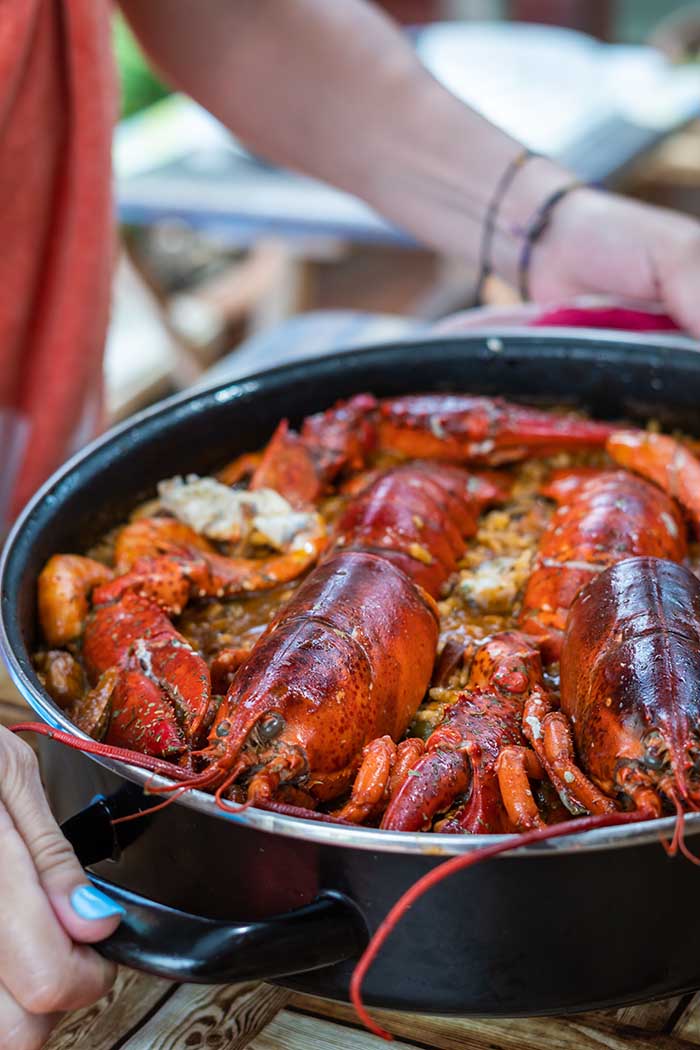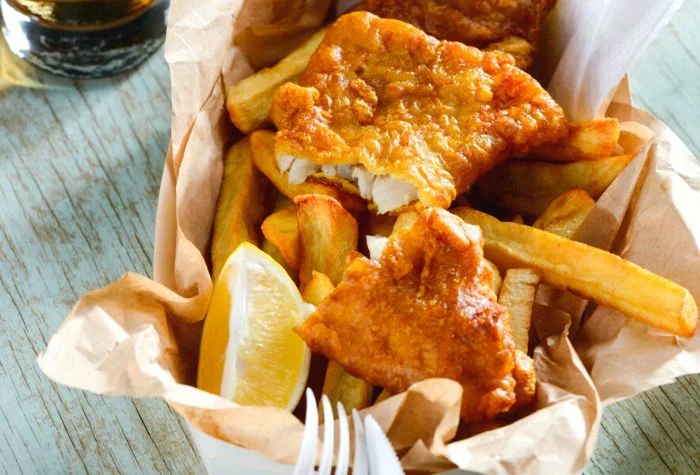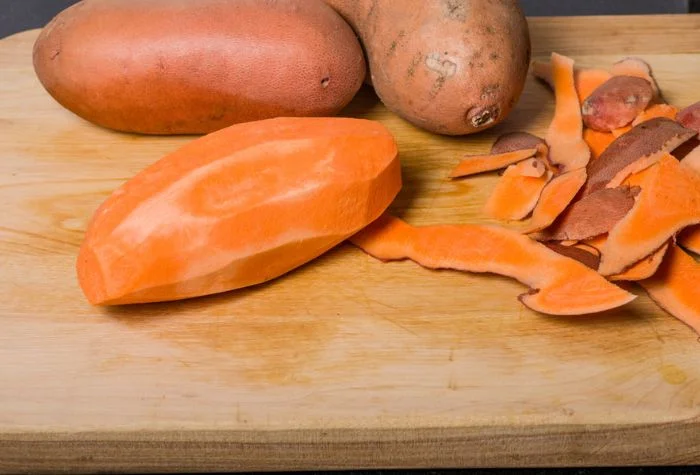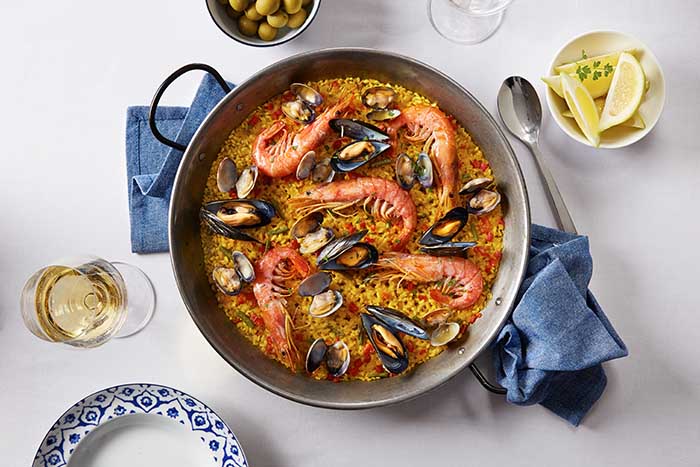The best types of lobster for your next recipe. From Maine lobster to Canadian, and French Blue to Caribbean, discover the differences, seasons, and best cooking methods for our favorite types of lobster.

Anyone for a lobster? Restaurant goers and food fanatics have been enjoying fresh lobster for centuries, and it’s no wonder why: The culinary classic has a sweet but clean taste, with a fleshy texture completely different from most other types of seafood.
Not every type of lobster is the same. And whether you’re preparing it steamed, boiled, or grilled, you need the right kind that’s best for your cooking method.
Today we’re breaking down the best types of lobster for cooking, looking at their defining characteristics, and how best to enjoy them. Let’s get into it!

Lobsters Explained
Lobsters are popular mainly because they are very tasty to eat. It is also very high in protein and other nutrients. Back in the day, lobster was said to be a poor man’s food. It used to be served in several prisons. However, it became a symbol of good living when it started getting canned and could now be shipped worldwide. It became more of a rich man’s food around the mid-19th century.
It is best served fresh, which means that it is more abundant in coastal towns, and this is one of the many reasons it is more popular. The more complicated something is to get, the more sought-after it will be. With lobster, a lot goes into getting them from the water to your plate, which drives up the price and increases interest among people.
Warm Water Lobster
A warm water lobster is also known as rock lobster or spiny lobster. Instead of the traditional claws, you may be more accustomed to seeing as a typical lobster, warm water lobsters have what look like antennae instead, which are the front set of legs. They come from warmer climates, where the water is also warm, hence the name, warm water lobster.
Along with the shell, spikey bits protrude from the shell, and are used as a defense mechanism, to protect them in the wild. The only part that you can eat from a warm water lobster is the tail. Warm water lobsters are also much more affordable.
Cold Water Lobster
Cold water lobsters are also known as clawed lobsters. They have five sets of walking legs and three sets of claws. One of the reasons this type of lobster is most popular is that it has more meat to go around the table. They will have meat in both their claws and in their tails. Also, the meat is sweeter than warm water lobsters. The meat from cold water lobsters is whiter than what you will find on other lobsters.
Caribbean
Caribbean lobsters are most commonly found along the continental shelf of the southeastern United States, usually from North Carolina to Texas, in Bermuda, throughout the Caribbean Sea, and south to Brazil. It can also be found in the Gulf of Mexico and will cost you on average $30 a pound depending on whether they are frozen or fresh.
Caribbean lobsters have a characteristic spiny outer shell, which is also reddish-brown. Instead of claws, they have antennae which are also used to scare predators. There are two large cream-like spots on the top of the second half of the shell. When it comes to flavor and texture, it is firm and has a mildly sweet and succulent flavor. As for seasons, it depends on where you go. In the Bahamas, lobster season is from August until the end of March.
South African
South African lobster is a warm water lobster from South Africa. It will cost you about $45 per pound of lobster. The South African lobster tail is both sweet and juicy, which is why it is a delicacy. They grow slower than Caribbean lobster, and this influences the overall taste. These tails have a characteristic reddish-orange color. In most cases, it is served with a buttery sauce and paired with chardonnay. The best season to get them is between November and April.
Australian
This lobster is from the northwest coastal parts of Australia and also in New Zealand. They are available in both green and red varieties. The meat is firm, and the flavor is mildly sweet. The taste is smooth and delicate. The Australian lobster tail weighs about eight to ten ounces. Each tail will often cost about $25 -$35 or about $45 – $60 per pound. This will depend on where you buy them. They are available all year round.
Reef
These lobsters have claws; however, they are not termed clawed lobsters. They have 1 set of claws and have purple-like markings. The color is often why these lobsters are kept. They are smaller in comparison with other lobsters. They are often found in the warm parts of the Atlantic. A 2-inch lobster will cost about $20.
California
These spiny lobsters are often from the coast of Monterey Bay, CA, to Mexico. These are often commercially sold and shipped across the globe. They can grow up to 24 inches long, and the average price is about $25 per pound. They are in season between October and March. When it comes to flavor, California lobster is sweet and delicate with creamy and nutty notes.
Canadian
Canadian lobsters are often harvested for the meat in their claws. They are found on the coasts of Canada and are part of the Homarus americanus, along with Maine lobster, and this is why they are usually confused for each other. Canadian water is cold, and as such, the lobster is cold water lobster.
Canadian lobster has a much sweeter and more refined taste. The meat is also denser. They are in season between October and January, and also between June and July. On average, a pound of frozen Canadian lobster will cost about $65. At the same time, the live lobster will be about $20 a pound.
Maine
These are often confused with Canadian lobsters. They both belong to the Homarus americanus family. They have juicy and succulent claw meat and lots of it.
This is one of the reasons why it is a popular lobster. There is more meat per pound. Maine lobsters also have meat in the tail. Unlike other lobsters that will just have meat in the tail and not in the claws. As such, it feels like you’re getting more value for your money, with more meat per pound.
It is often named as the best lobster on any seafood menu. The flavor profile is sweet and briny with a rich taste all at the same time. The meat from the tail is fibrous and also quite firm. The price of Maine is usually high. However, it is highly dependent on the location and how far out the lobster had to be flown in. however, you can expect it to average about $50 a pound.
While it is in season all year round, the peak season for Maine lobster is between June and December.
New Zealand
The New Zealand lobster comes from the South Pacific coastal deep waters. The shell is a deep scarlet color, which can look pretty impressive on just about any plate. New Zealand lobsters come in 2 different species: the spiny rock lobster and the packhorse rock lobster.
The meat from this lobster is pretty smooth and yet firm as well. The taste is velvet-like and almost buttery. While it is harvested in New Zealand, it is often flown out quickly to be sold and cooked in different ways. The taste is mildly sweet and also quite meaty.
The best season for the New Zealand lobster is between May and February. The price of the lobster will depend highly on how far it had to travel. You can expect New Zealand lobster to cost about $50-$60 a pound on average.
Slipper
Slipper lobsters are non-clawed lobsters that have antennae instead. Unlike other lobsters, these bury themselves in mud and not in holes. They have distinctly flat faces. The mud gives them a taste that is not always desirable. As such, they are not as sought after. This doesn’t mean you can’t eat them. They are just not as popular on the commercial circuits. These lobsters are in season between November and April. The meat is sweet and firm.
Cooking Hard vs. Soft Shell Lobsters
It is essential to understand the difference between the two types of lobsters to know what to expect when you cook them. Hard-shelled lobsters have had more time to grow. They are more common in the colder seasons. In comparison, soft-shelled lobsters are more prevalent in warmer climates.
Soft-shelled lobsters have a sweeter and saltier flavor. Hard-shelled lobster has a fishier taste. Softshell lobsters have less meat to cook in comparison to hard shell lobsters. They also have softer textured meat as compared to hard shell lobsters, which have firmer meat.
What Factors Affect the Flavor of Lobster
Different factors affect them and influence the taste of lobster. Here are some of those:
Season
Lobsters are seasonal. And getting them at the right time can significantly influence how fresh they are. During the colder months, the meat is often firmer. To ensure freshness, make sure that you know the molting season of the lobster that you want to get.
Provenance
Location counts greatly when it comes to how fresh the lobster is. The way the lobster tastes is also dependent on where it has spent its days: the water and the surrounding features. Also, where it is from determines the amount of time it would take to transport it and its logistics. The closer you are to the source of the lobster, the more you can rely on having fresher lobster.
Age
Older lobster is tougher. The smaller, more tender, and younger lobsters have more flavor than the older ones with tough meat.
Freshness
If the lobster has been frozen and thawed, that may also affect the taste of the meat.


